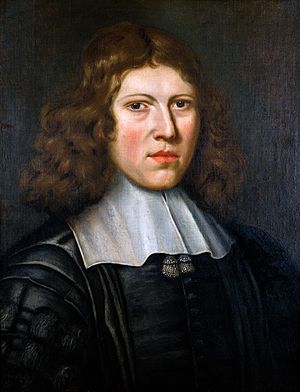Richard Lower (physician) facts for kids
Quick facts for kids
Richard Lower
|
|
|---|---|
 |
|
| Born | 1631 Tremeer House, Bodmin, Cornwall
|
| Died | 7 January 1691 (aged 59–60) |
| Alma mater | Christ Church, Oxford |
| Known for | Neuroanatomy and transfusion studies |
| Scientific career | |
| Fields | Medicine |
| Doctoral advisor | Thomas Willis |
| Influences | Robert Boyle |
Richard Lower (c. 1631 – 17 January 1691) was an English doctor. He made very important discoveries that changed medical science. He is best known for his early work on blood transfusion (giving blood to people). He also studied how the heart and lungs work. He wrote about these ideas in his famous book, Tractatus de Corde.
Contents
Who Was Richard Lower?
Richard Lower was born in St Tudy, Cornwall. He went to Westminster School where he met John Locke. Later, he studied at Christ Church, Oxford, and met Thomas Willis. Willis was a famous doctor. Lower followed Willis to London to do more research on the human body. He sometimes worked with Robert Hooke, another famous scientist.
Early Life and Education
Lower was part of a group of scientists who did experiments at the University of Oxford. This was during a time when England was changing its government. He was a pioneer, meaning he was one of the first to do experimental physiology. This is the study of how living things work by doing experiments.
Lower studied medicine under Thomas Willis. He earned his medical degree in 1665. After that, he worked with Willis to learn more about the nervous system.
Discoveries About the Heart and Lungs
Richard Lower started his own research on the heart. He carefully studied how blood moves through the lungs. He found that blood changes when it touches air. He was the first person to see the difference between blood in arteries and blood in veins. Arteries carry blood away from the heart, and veins carry it back.
The Tractatus de Corde
Lower's most important book was Tractatus de Corde (1669). This book was all about how the heart and lungs work. In it, he described the muscles of the heart. He also wrote about how blood clots in the heart. He even studied how fluids move in the body during digestion. Lower showed his book to the Royal Society in 1669.
Pioneering Blood Transfusions
The idea of giving blood from one living thing to another started in Paris. A French monk first talked about it in 1658. Richard Lower showed that blood could be moved from one animal to another. In February 1665, he did the first successful blood transfusion between two dogs.
Transfusions in Humans
Inspired by Lower's work, a French doctor named Jean-Baptiste Denis tried the first animal-to-human blood transfusion. This was called xenotransfusion. He gave sheep's blood to a 15-year-old boy. Soon after, in November 1667, Lower and another student of Willis, Edmund King, also gave sheep's blood to a man. Lower hoped this might help the man, or at least teach them more about science.
It was hard to find people who would agree to a transfusion. But a scholar named Arthur Coga agreed. Lower and King performed the procedure in front of the Royal Society on November 23, 1667.
Why Transfusions Stopped
Blood transfusions became a bit popular in France and Italy. But soon, doctors and religious leaders started to argue about them. Because of these debates, transfusions were made illegal. The French Parliament banned them in 1670. The English Parliament quickly did the same.
Brain and Fluid Studies
Lower also studied the brain. He looked at the circle of arteries at the bottom of the brain. This circle is now called the circle of Willis, named after his teacher. Lower wanted to see if blood would still flow to the head if some of the main arteries were tied off.
Understanding Brain Fluids
Lower also tried to understand how cerebrospinal fluid (fluid around the brain and spinal cord) was made. He also studied how it moved around. These experiments helped him learn about hydrocephalus. This is a condition where too much fluid builds up in the brain.
In Lower's time, people thought that catarrh (a runny nose or inflammation) was caused by fluid leaking from the brain to the nose. Lower wrote a book called De Catarrhis. This book was important because it was the first time an English doctor used scientific experiments to prove an old idea wrong.
Later Life and Legacy
Thomas Willis died in 1675. After that, Richard Lower became very busy with his medical practice. He even took care of King Charles II when the king was very ill in 1685.
When James II became king, Lower did not continue as the court doctor. This was because of his political and religious beliefs. However, he was still asked for advice by the woman who would later become Queen Anne, when she was pregnant.
Richard Lower died in London from a fever in 1691.
See Also
- List of Cornish people
- William Lower (dramatist), a cousin
- Lower, Richard: Englisches Artzney-Büchlein . Vol. 1&2 . Gleditsch, Leipzig 1717 by the University and State Library Düsseldorf

